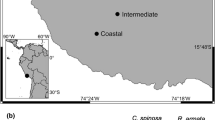Abstract
If climate limits the geographical distribution of a species, local variation in microclimate may affect the species' local distribution at the edge of its range. We hypothesized that warm urban microclimates may explain the distribution of the Virginia opossum (Didelphis virginiana) in central Massachusetts. We recorded winter temperatures with data-logging sensors in urban, coniferous, deciduous, and open habitats in the human-dominated landscape of the Connecticut River Valley of Massachusetts. Overall, temperatures decreased with elevation. Daily maximum temperatures, a variable used in models of opossum biophysical constraints, were lowest at forested sites, intermediate at urban sites, and highest at open sites; however these were a poor indicator of evening temperatures, which are important to the nocturnal opossum. Open sites had the highest daily temperature fluctuations, and were the coldest at night. Urban and coniferous sites had the least pronounced daily fluctuations in temperature, and urban sites had the warmest nights. Habitat-specific winter temperatures in the Connecticut River Valley indicated that urban sites were most conducive to opossum persistence, but even they were unlikely to sustain populations. Other factors likely help mitigate the influence of harsh climatic conditions on persistence of opossum populations in western Massachusetts.
Similar content being viewed by others
References
Brazel, A.J., Selover, N., Vose, R. and Heisler, G. (2000) The tale of two climates: Baltimore and Phoenix LTER sites. Climate Research 15, 123–135.
Brocke, R.H. (1970) The winter ecology and bioenergetics of the opossum, Didelphis marsupialis, as distributional factors in Michigan. Doctoral Dissertation. Michigan State University, Michigan.
Crooks, K.R. (2002) Relative sensitivities of mammalian carnivores to habitat fragmentation. Conservation Biology 16, 488–502.
Danielson, W.R., DeGraaf, R.M and Fuller, T.K. (1997) Rural and suburban forest edges: effect on egg predators and nest predation rates. Landscape and Urban Planning 38, 25–36.
Gardner, A.L. and Sunquist, M.E. (2003) Opossum. In Wild mammals of North America: biology, management, and conservation(G.A. Feldhamer, B.C. Thompson and J.A. Chapman, eds), pp. 3–29. Johns Hopkins University Press, Baltimore, Maryland.
Humphries, M.M., Thomas, D.W. and Speakman, J.R. (2002) Climate-mediated energetic constraints on the distribution of hibernating mammals. Nature 418, 313–316.
Kanda, L.L. (in press) Winter energetics of Virginia opossums (Didelphis virginiana) and implications for the species' northern distributional limit. Ecography.
Kanda, L.L. (2005). Factors influencing the survival and reproduction of Virginia opossums (Didelphis virginiana) at their northern distributional limit. Doctoral Dissertation. University of Massachusetts, Amherst, Massachusetts.
Kanda, L.L., Fuller, T.K. and Friedland, K.D. (in press) Temperature sensor evaluation of opossum winter activity. Wildlife Society Bulletin.
Kanda, L.L. and Fuller, T.K. (2004) Demographic responses of Virginia opossums to limitation at their northern boundary. Canadian Journal of Zoology 82, 1126–1134.
McKinney, M.L. (2002) Urbanization, biodiversity, and conservation. Bioscience 52, 883–890.
National Oceanic and Atmospheric Administration. (1973–2004) Climatological data: Amherst, Massachusetts. National Climatic Data Center, Asheville, North Carolina.
SAS Institute Inc. (1999) SAS OnlineDoc version 8. SAS Institute Inc., Cary, North Carolina.
Slaymaker, D.M., Jones, K.M.L., Griffin, C.R. and Finn, J.T. (1996) Mapping deciduous forests in Southern New England using aerial videography and hyperclustered multi-temporal Landsat TM imagery. In Gap Analysis: A Landscape Approach to Biodiversity Planning (J.M. Scott, T.H. Tear and F.W. Davis, eds.), pp.87–101. American Society for Photogrammetry and Remote Sensing, Bethesda, Maryland.
Tyndale-Biscoe, H. (1973) Life of Marsupials. Edward Arnold, London, England.
University of Massachusetts Amherst Housing Services. (2004) Living at UMass. University of Massachusetts, Amherst, Massachusetts.
U.S. Census Bureau. (2003) Population and Housing Unit Counts PHC-3-23, Massachusetts. 2000 Census of Population and Housing. Washington, D.C.
Author information
Authors and Affiliations
Corresponding author
Rights and permissions
About this article
Cite this article
Kanda, L.L., Fuller, T.K., Sievert, P.R. et al. Variation in winter microclimate and its potential influence on Virginia opossum (Didelphis virginiana) survival in Amherst, Massachusetts. Urban Ecosyst 8, 215–225 (2005). https://doi.org/10.1007/s11252-005-4381-y
Issue Date:
DOI: https://doi.org/10.1007/s11252-005-4381-y




